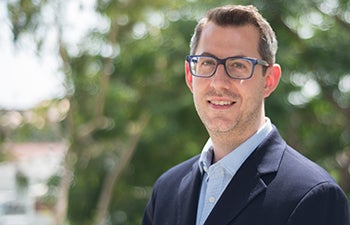
Don’t take love for granted: A new course challenges our preconceived ideas about romance, eroticism and religion
“Eros shook my mind / Like a mountain wind falling on oak trees.”
Despite their contemporary sound, these stirring lines are not taken from the lyrics of a popular indie-rock song. In fact, they were penned more than 2,600 years ago by the Greek poet Sappho.
That knowledge makes it easy for us to see them as yet another testament to what we in the modern world tend to assume is the unchanging, eternal nature of love.
However, David Albertson, associate professor of religion, who is challenging our long-held ideas about love in his Thematic Option course, “Love and Its Reasons: Eros and Transcendence,” would question that assumption.
“I doubt many USC students think of love as something with a history that can be studied in faculty research and taught in the classroom, but we’re doing both this term,” Albertson said of the new freshman humanities course.
Questioning love
The mysterious experience of love has been central to western art and literature for centuries — so much so, Albertson argues, that in our popular culture, in film, music and romantic literature, we tend to take love for granted. However, the topic of love has also played a major role in philosophy and religion throughout the ages.
“Although it’s disorienting for us to think about love outside the familiar frame of romance in popular music and film, in fact there are many deeper questions that can be asked,” he said.

Associate Professor of Religion David Albertson. Photo by Peter Zhaoyu Zhou.
“Our course tries to broaden students’ thinking about love and their conceptual vocabulary about different experiences of love, desire and ecstasy.”
Are there many kinds of love or just one? How does love alter the boundaries of the self? Is sexual desire a property of body or soul? How is it that love is both joyful and painful? These are some of the questions students are pursuing through extensive reading of texts, both ancient and modern, including works by Plato, Ovid, Augustine, Shakespeare, Dante, Goethe and Kierkegaard, as well as a range of medieval women mystics.
Love and religious desire
To introduce students to the concept of love and religious desire, Albertson invited them to consider Gian Lorenzo Bernini’s iconic sculpture, “The Ecstasy of Teresa of Avila.”
“We think when someone’s speaking about love in terms of religious desire that it boils down to a projection of some physical reality,” Albertson said. “Teresa is shown having a mystical, ecstatic experience, but it looks at first like a physical, erotic experience that’s been projected into the religious sphere.”
However, Albertson says, this is a mistake. “In the ancient world, at least, and for many authors of the Middle Ages, women and men, it was quite the reverse. They considered that any sort of physical, sexual experience was simply an inadequate shadow of the real, erotic experience that the soul was having with the divine.”
In fact, in mystical literature, love often has nothing to do with another human individual. Instead, love is the contemplative and mystical quest to unite one’s soul with that of the divine beloved, what some authors even call an intellectual discipline of “erotics.”
“It’s explicitly supposed to be an erotic encounter or even fusion of the soul with God,” Albertson explained. “For thinkers like Plato and even for some ancient Christians, physical manifestations of desire in the body were only an after-image of the real thing.”
Such beliefs are at the root of a long-standing question in Christian thought, especially in Christian mysticism — is it easier to reach mystical union with God through the intellect, knowledge and the mind, or through love, the will and desire?
The evolving concept of love
Freshman Michelle Olson, who is majoring in interactive entertainment at USC School of Cinematic Arts, said she was motivated to take Albertson’s course after studying Fyodor Dostoyevsky’s The Brothers Karamazov in high school. “As someone who thoroughly enjoyed the novel’s deep religious themes and who found it profoundly changed my personal views on love and religion, I was excited to see what other sort of prominent philosophies about love and its relation to God were out there,” she said.
She was surprised to discover how many early Greek philosophers took a deeply pessimistic view of love. “One poem in particular written by Sophocles in Antigone painted love as something tyrannical and destructive — a perspective on love we don’t often see in modern writing,” she said. Comparing this negative view of love with subsequent philosophies allowed her to understand how perspectives on love evolved over the centuries, she said.
“Viewing complex topics like love through different philosophical and religious lenses is incredibly enlightening and allows me to better form my own views and better understand those of others,” she said.
New translation to fill gap in scholarship
Albertson will soon be adding to the available scholarship on the subject with his new translation project, “The Tegernsee Debate on Love and Reason: Mystical Letters and Treatises in Late Medieval Germany,” for which he was recently awarded a three-year National Endowment for the Humanities grant. This resulting volume will translate 15th-century Latin texts from an important Benedictine monastery in Germany, and will also examine how such Christian notions of love and reason found common ground with Judaism and Islam.
“This project will fill a gap in existing scholarship,” he said, “and provide an English version of some fascinating texts I’d like to read with USC students in the future.”